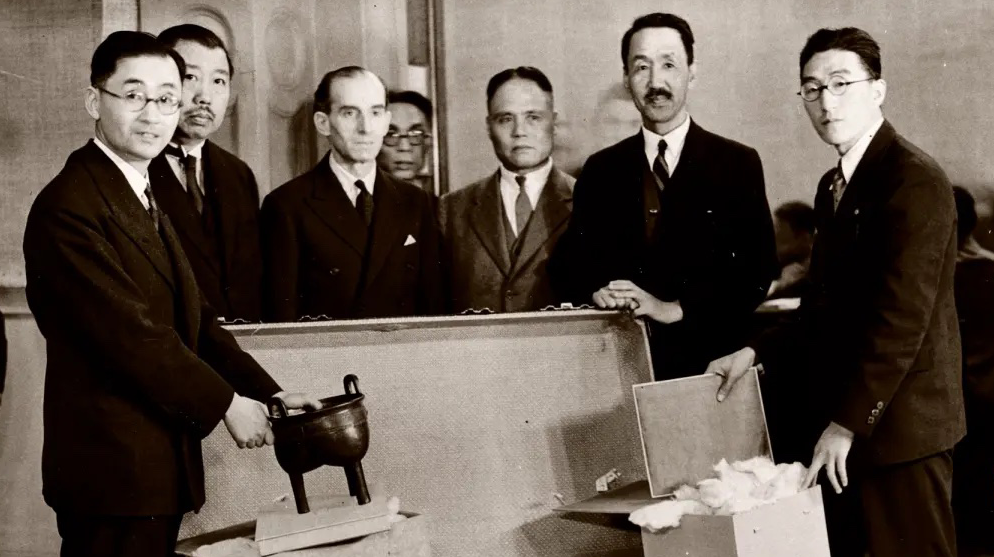Problematising collector/collection histories: writing a critical biography

A workshop with scholar Stacey Pierson about writing a biography that is critical rather than hagiographic.
Percival David, Exhibition Director; Zheng Tianxin (Dr F.T. Cheng), Special Commissioner of the Chinese Government and Zhuang Shangyan (Chuang Shang-Yen) and Tang Xifen (Tang Hsi Fen), Secretaries accompanying objects. The International Exhibition of Chi, 1935. Black and white silver gelatin print. 197 mm x 251 mm. © Photo: Royal Academy of Arts, London.
This seminar will examine the process of writing a critical biography of an art collector and their collection(s). Biographies of collectors are a sub-category of biography that foreground a collecting life, one that is traditionally seen to be underpinned and driven by the formation of the collection(s). Writing such a life history thus encompasses the aims and source materials for a standard biography but it is complicated by the additional presence of the collection(s) and its role in shaping that biographical narrative. In some ways, as an organizing principle, collections make the writing of a biography more straightforward, especially for the art historian. But this approach requires embracing the somewhat uncritical assumption that the collection and collecting practices are a defining feature of a life.
In order to write a more critical biography of a collector, rather than a hagiography, a new approach might be required. In this seminar, a work-in-progress on the collector Sir Percival David will be used as a case study to develop and discuss key questions and problems that might be used as a guide for the critical biographer. For example, a primary issue that arises in collector biographies is the interconnectedness of collector and collection. Does one define the other? Should one define the other? The collector may have made it seem that way in their lifetime but how important is their truth to the critical biographer and to the reader’s understanding of the biographical subject? There is also the seeming inevitability of ‘the collection’, the significance of motivation, and the role of collections in identity formation. These and other issues and questions will be explored in the seminar and participants are invited to bring their own examples to the discussion.
Readings
Lady David, ‘Sir Percival David’, in R. Scott, ed., Imperial Taste: Chinese Ceramics from the Percival David Foundation’, Los Angeles, 1989: 9-14.
Howard Hansford, ‘Obituary. Sir Percival David’, Bulletin of the School of Oriental and African Studies , Volume 28 , Issue 2 , June 1965 , pp. 472 – 475, DOI: https://doi.org/10.1017/S0041977X00076060.
Co-presented by the Power Institute and VisAsia at the Art Gallery of NSW.
People

Stacey Pierson
Dr Stacey Pierson is Professor of the History of Chinese Ceramics at SOAS, University of London. In addition to teaching and supervising research students in the School of Arts, she is President of the Oriental Ceramic Society (London) and series editor for the Routledge title Histories of Material Culture and Collecting, 1550-1950. Previously, from 1995 – 2007, she was Curator of the Percival David Foundation of Chinese art, also at the University of London, which housed the world-renowned David collection of Chinese ceramics. She has published widely on aspects of Chinese ceramics and the history of collecting and exhibitions, including Collectors, Collections and Museums: the Field of Chinese Ceramics in Britain: 1560-1960 (2007), Chinese Ceramics: a Design History (2009), From Object to Concept: Global Consumption and the Transformation of Ming Porcelain (2013), Private Collecting, Exhibitions and the Shaping of Art History in London: the Burlington Fine Arts Club, 1866-1950 (2017) and the edited volume Visual, Material and Textual Cultures of Food and Drink in China, 200 BCE – 1900 CE, Colloquies on Art and Archaeology in Asia, no. 25 (2022). Her most recent research project focused on Dr Johnson’s Chinese teapot, which is on display in the British Museum.
